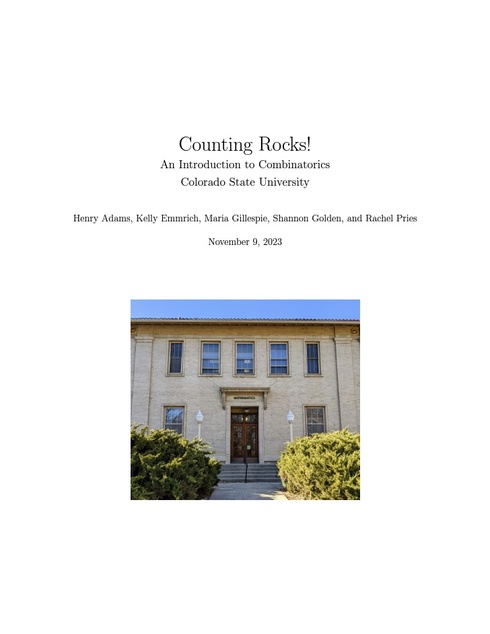
Counting Rocks! An Introduction to Combinatorics
No ratings
Henry Adams, University of Florida
Kelly Emmrich, Colorado State University
Maria Gillespie, Colorado State University
Shannon Golden, Colorado State University
Rachel Pries, Colorado State University
Copyright Year:
Publisher: Henry Adams, Rachel Pries, and Maria Gillespie
Language: English
Formats Available
Conditions of Use
![]() Attribution
Attribution
CC BY
Table of Contents
- Preface
- Contents
- What is combinatorics?
- Counting principles
- Counting combinations
- Pascal's triangle and the Binomial Theorem
- Proof techniques in combinatorics
- Recurrence relations
- Generating functions
- Graph theory basics
- Trees
- Graph optimization
- Planar graphs
- Graph coloring
About the Book
This textbook, Counting Rocks!, is the written component of an interactive introduction to combinatorics at the undergradaute level. Throughout the text, we link to videos where we describe the material and provide examples; see the Youtube playlist on the Colorado State University (CSU) Mathematics YouTube channel.
The major topics in this text are counting problems (Chapters 1-4), proof techniques (Chapter 5), recurrence relations and generating functions (Chapters 6-7), and graph theory (Chapters 8-12). The material and the problems we include are standard for an undergraduate combinatorics course. In this text, one of our goals was to describe the mathematical structures underlying problems in combinatorics. For example, we separate the description of sequences, permutations, sets and multisets in Chapter 3.
In addition to the videos, we would like to highlight some other features of this book. Most chapters contain an investigation section, where students are led through a series of deeper problems on a topic. In several sections, we show students how to use the free online computing software SAGE in order to solve problems; this is especially useful for the problems on recurrence relations. We have included many helpful figures throughout the text, and we end each chapter (and many of the sections) with a list of exercises of varying difficulty.
About the Contributors
Authors
Henry Adams, University of Florida
Kelly Emmrich, Colorado State University
Maria Gillespie, Colorado State University
Shannon Golden, Colorado State University
Dr. Rachel Pries, Colorado State University
